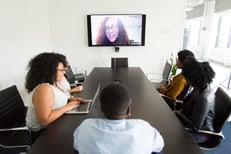With the Covid-19 pandemic creating a major shift in how we interact with our colleagues and friends, this has had a fundamental impact on the recruitment process.
The most significant change is the reduction of face-to-face contact which clearly impacts on an employer’s ability to assess a candidate interviewing for a role. In order to continue to deliver some element of face-to-face assessment, virtual interviewing through video has become an increasingly crucial part of the recruitment process.
So what approach should be taken with virtual interviewing to ensure effective assessment of a candidate?
The essentials don't change...
Just because it’s a virtual interview doesn’t remove the need for the interview basics. Being properly prepared remains essential and you should always ensure the candidate is sent the virtual invitation and accompanying material in the same way as you would for a meeting in person.
Ensuring you are in a quiet, confidential room to interview the candidate as though it was a face-to-face interview is still vitally important. Make sure you will not be disturbed and there’s no background noise or activity that might distract a candidate.
Having well-prepared, properly structured questions to ask will also continue to be a necessary requirement for virtual interviews. Just because the candidate isn’t in the room, doesn’t mean you should be any less prepared – quite the opposite in fact. It will be even more important that you are engaged and constantly present in the virtual scenario. Similarly, a candidate should be as prepared as they would be for an interview in person and have done the same level of homework on your organisation.
Dress code and body language will also remain key. You should dress as professionally as you would if it was an interview in person. In addition, although some elements of body language will be harder to maintain and gauge through virtual interviewing, others can be e.g. sitting up straight and maintaining eye contact with the camera. This will be equally applicable for the candidate as well, so you can get an indication of their confidence from this.
...however some things will be different

The most obvious difference between a virtual interview and a face-to-face one is the technology and making sure it works. It’s vitally important you have tested the connection and strength of signal as well as the software that you are using and the hardware you will be using it on. Nothing will be more frustrating for both parties if the signal doesn’t work or keeps cutting out resulting in misheard questions and answers.
In addition, if you have multiple interviewers sat in different places, this can create greater complexity and lack cohesion, so ensure you have an agreed process in place in advance e.g. who is going to ask which questions etc…
Given the reduction in the ability to assess a candidate’s body language, there is greater emphasis on the need for in-depth listening to candidate’s answers and tone of voice. If you have an ability to record the session (with the candidate’s permission), it’s worth doing, so that you can really focus on listening to a candidate’s answer and not get distracted by having to write down what they are saying. You can then play back and review the recording if required after the interview is over.
A further major difference with virtual interviewing compared with interviewing in person is the organisational culture and environment. Many candidates will get a feel for the culture of an organisation from the moment they set foot inside the organisation’s office. As this doesn’t happen with virtual interviewing, it’s vitally important an emphasis is placed on this aspect within the interview itself. Make sure you reinforce your employer brand by conveying what the organisation is like to work for and the environment a candidate can expect to operate in if appointed.
Benefits
Whilst virtual interviewing does remove the ability for you to assess a candidate in person, it also provides a number of benefits.
A candidate is likely to be more comfortable and at ease if they are in their own environment, which in turn, is likely to lead to more natural and expansive answers.
With no travel time to your offices required, virtual interviewing can accommodate a variety of schedules. For example, a candidate can be more flexible in terms of when they can interview as they may not need time off from their existing job to attend. Also, international candidates can often be more flexible in terms of time differences.
Recording a virtual interview may also be possible although you must always explain clearly how the recording will be used, and get the consent of the candidate. This could be useful if you don’t get the chance to write every answer down or to share with colleagues who were unable to take part in the interview.
Summary
As Covid-19 increasingly creates new challenges on various aspects of the business world, the recruitment world has been quick to embrace the technology to enable a more streamlined recruitment process through virtual interviewing.
Whilst some of the fundamentals of a good interview remain the same regardless of whether the interview is in person or virtual, there are some additional aspects to virtual interviewing that should be considered to ensure it is an effective interview. In particular, ensuring the technology works well and the organisational culture is highlighted will be crucial to helping a candidate overcome the disadvantages of not meeting in person.
The additional benefits that virtual interviewing delivers can also help offset some of the disadvantages of not being able to meet the candidate in person.

